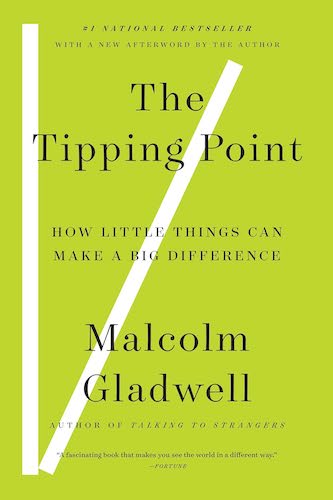The Tipping Point
Summary reviewed by:
Terrence Timmons
Terrence Timmons
Analyst
Bachelor of Arts (BA), University Of California, Santa Barbara 2019
With over 4 years of experience as an analyst. Terrence Timmons is committed to analyzing summaries without compromising on quality.
The Tipping Point: How does Change Happen? Discover the Magic Moment when the Unnoticeable Becomes Unstoppable with Malcolm Gladwell!
In "The Tipping Point: How Little Things Can Make a Big Difference," Malcolm Gladwell presents the riveting proposition that significant societal changes occur much like epidemics: they begin small, gather momentum, and then reach a critical 'tipping point' where they rapidly spread. Gladwell’s central thesis is that understanding the dynamics of this tipping point can offer potent insights into how ideas, behaviors, or products become viral phenomena.
To demystify this concept, Gladwell introduces three critical factors: the Law of the Few, the Stickiness Factor, and the Power of Context. He illustrates these laws through a wide range of fascinating examples, from the sudden popularity of Hush Puppies shoes, the reduction in New York City's crime rates, to the swift spread of the HIV/AIDS epidemic.
Gladwell argues that only a few people – the Connectors, Mavens, and Salesmen, who have a unique social structure, expertise, or persuasive power, are essential in triggering a 'social epidemic.' He examines the 'stickiness factor,' the unique quality that compels a phenomenon to stick in the collective memory. Lastly, he discusses the power of context, demonstrating how environmental and situational conditions can significantly impact the likelihood of a tipping point occurring.
"The Tipping Point" is a remarkable exploration into the dynamics of social phenomena, casting light on how minor tweaks in approach can lead to seismic shifts in outcomes.
Non-fiction
Social Science
Psychology
Business & Economics
Connectors are individuals with wide social circles. They are the people who “link us up with the world…people with a special gift for bringing the world together.”
Mavens are information specialists. They accumulate knowledge and understand how to share it with others. They are “people we rely upon to connect us with new information.”
Salesmen are persuaders with charismatic personalities, capable of selling or promoting ideas.
Law of the Few: Gladwell presents the idea that select individuals (Connectors, Mavens, and Salesmen) play a pivotal role in sparking social epidemics.
Stickiness Factor: He explores the quality that makes a message memorable, leading it to ‘stick’ in people’s minds.
Power of Context: The author elucidates how environmental and situational conditions can significantly influence behaviors and trends.
Social Epidemics: Throughout the book, Gladwell investigates the concept of ‘tipping points’ as they apply to social phenomena, drawing comparisons with how diseases spread.


Date Published: January 7, 2002
Disclaimer: As an Amazon Associate I earn from qualifying purchases.